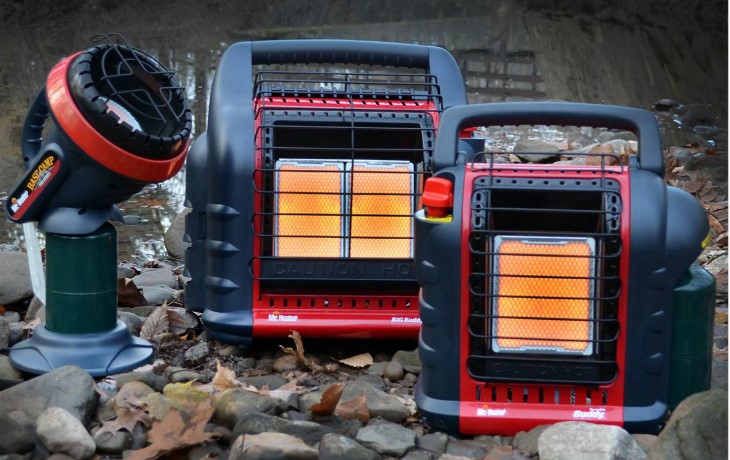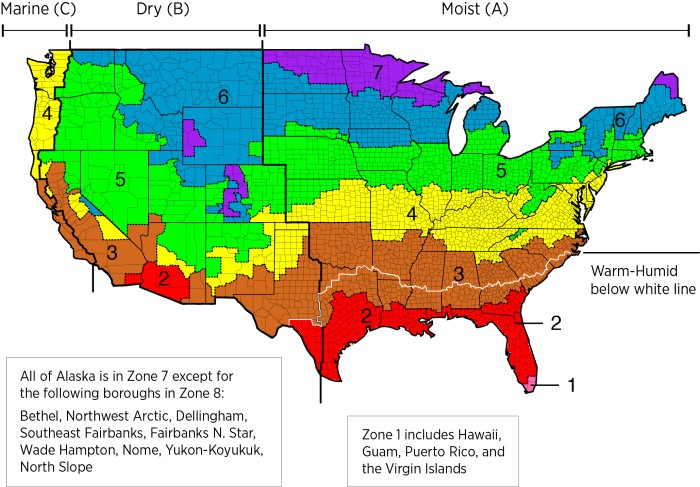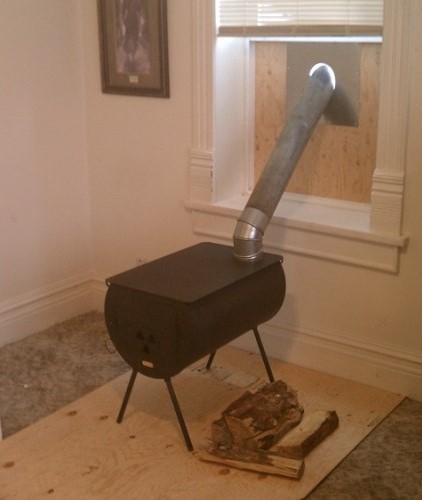The most important bits:
- The most common fuel types are propane, kerosene, alcohol, and organics like wood.
- Most people who don’t have usable wood on or very near their property end up with propane.
- Propane gives off more BTUs (amount of heat) when compared to kerosene and denatured alcohol.
- Propane can last indefinitely (your tank is likely to expire before the fuel) and is relatively easy to store.
- People with asthma or respiratory issues tend to do better with wood stoves and propane heaters. There are reports that kerosene heaters can cause lung irritation.
- Propane space heaters will not work well above 9,000 feet of elevation because the “low oxygen” safety sensors can trip. Consider a wood or alcohol stove if you live at high altitude.
- Pellet stoves are fine for daily life, but they aren’t a great prep since they require electricity.
- Heaters designed for outdoor use should never be used in closed-air spaces because of carbon monoxide poisoning — this is one of those warnings you should actually listen to!
- Propane and kerosene heaters designed for indoor use are generally safe, but you should have a carbon monoxide sensor in your home just in case.
- Space heaters should be kept multiple feet away from blankets, furniture, and other items that can catch fire. Keep a fire extinguisher close just in case you do have a fire.
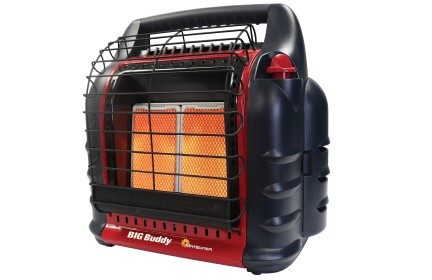
Best for most:
Mr. Heater Big Buddy Portable Heater
The best choice for most is the Mr. Heater Big Buddy Portable Heater. Mr. Heater offers a range of indoor-safe portable heaters that can run off 1-lb propane tanks or connect to a 20-lb propane tank with a hose. The Portable Buddy Heater has low, medium, and high settings and can create up to 18,000 BTUs an hour, which can heat up a 450 square-foot room. The Big Buddy Portable Heater will shut off if it’s tipped over, has a low-oxygen sensor, and will work at elevations up to 7,000 feet. Plugged into a 20-lb tank, the Big Buddy can provide over 100 hours of heat. For those living in Canada or the state of Massachusetts, these heaters are not approved for indoor use
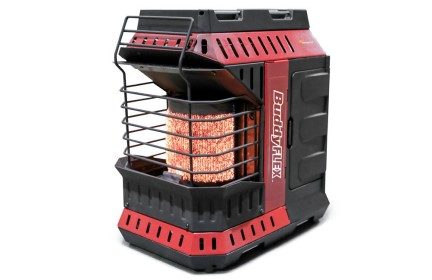
More versatile:
Mr. Heater Buddy FLEX Heater
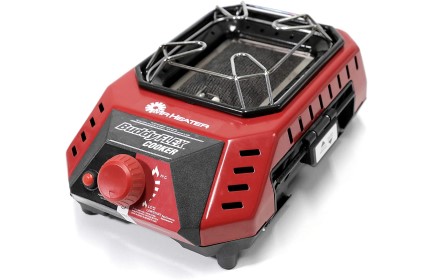
Cooking add-on:
Mr. Heater Buddy FLEX Cooker
The Mr. Heater Buddy FLEX heater is an upgraded version of the base Buddy series. The FLEX heater features an improved design that buffers against the wind when used outdoors. The housing has storage space for accessories and can attach to the Buddy FLEX cooking element, which plugs into the heater and can accommodate a frying pan or griddle. The Buffy FLEX heater can use both 1-lb propane canisters or hook up to a 20-lb tank, making up to 11,000 BTU per hour, which will heat a 275 square-foot room. Runs for 3.5 hours on a 1-lb cylinder or 38 hours on a 20-lb. Operates at an elevation of up to 9,000 feet. For those living in Canada or the state of Massachusetts, these heaters are not approved for indoor use
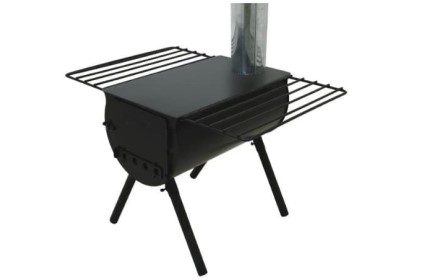
Wood heat and cooking:
Camp Chef Alpine Heavy Duty Cylinder Stove
If you want a totally off-grid solution that runs on organic materials like wood, it’s hard to beat a small camp stove, especially if you live in a wooded area. Small camp stoves can be easily set up in an emergency, with the chimney configured to vent through a window or other gap. Weighing in at 74 lbs, the Camp Chef Alpine is not a lightweight stove, but it comes packed with features such as adjustable legs, 10 feet of chimney pipe, a fire grate to protect from overheating, cooking range, and a shelf for drying. The Camp Chef Alpine is commonly used in remote parts of Alaska to heat plywood sheds for hunters and prospectors.
Contenders
Although not currently top picks, these models are worth a look if you want more shopping options:
- Dometic ORIGO 5100 Heat Pal Alcohol Stove
- Dura Heat Indoor Kerosene Heater
- Dura Heat LP 10-360 Indoor Propane Heater
- Dyna-Glo kerosene Convection Heater
- Mr. Heater Journey 6 Portable Catalytic Heater
- Mr. Heater Journey 8 Portable Catalytic Heater
- Mr. Heater Little Buddy Heater
- Mr. Heater Portable Buddy Heater
- US Stove Caribou Portable Camp Stove
- Winnerwell Woodlander Tent Stove
Be prepared. Don’t be a victim.
Want more great content and giveaways? Sign up for The Prepared’s free newsletter and get the best prepping content straight to your inbox. 1-2 emails a month, 0% spam.
BTUs: How much heat do you need?
Heat is measured in BTUs or British thermal units. A BTU is how much heat it takes to raise one pound of water by one degree Fahrenheit. Every heater has an advertised BTU output, either as a single number or a range. It’s essential to choose a heater that can sufficiently warm up your living area or survival space.
There are two factors in determining your BTU needs. The first is the area of your house you plan to heat in an emergency. If you have a small home, it may make sense to heat the whole thing, but for larger homes it’s more economical to heat only a section. For example, if you have a large enclosed room, like a master bedroom, it may make sense to only heat that room. If you don’t have large, open spaces in your home, buying multiple small heaters may make more sense—just make sure each heater can properly heat its assigned room.
Once you’ve decided on an area, you need to determine the square footage of that area. For rectangular rooms, multiply the length and width in feet.
If you’re dealing with a circular room, measure the radius of the room (from the center to the furthest edge), multiply the radius by itself, and then multiply that number by 3.14. So if the radius is 7 feet, 7 times 7 is 49, and then 49 times 3.14 is just under 154 feet.
For a triangular room, multiple the length and width and divide by 2.
For irregularly shaped rooms, or collections of open rooms, break the space into individual sections, calculate the square footage of each one, and then add them all together.
Once you have the square footage you intend to heat, you need to figure out which climate zone you live in. The United States is divided into eight IECC climate zones for the purposes of heating and cooling.
The zone you are in determines how many BTUs you need per square foot:
- Zones 1 and 2: 30 to 35
- Zone 3: 35 to 40
- Zone 4: 45
- Zone 5: 50
- Zone 6: 55
- Zone 7: 60
Once you determine your climate zone, you need to multiply your square footage measurement by the BTU per square foot requirement. For zones 1-3, which have a range, choose the lower range if your home is warm and well-insulated and the higher number if it’s not. If you’re unsure, go with the higher number.
For example, let’s say you’re in zone 4 and your cold-weather room is a 10×20 foot rectangle. The calculation would be (10 x 20) x 45, which breaks down to 200 x 45, or 9,000 BTUs.
Propane: radiant vs catalytic
The most common small off-grid heaters on the market are fueled by propane, and there are two types: radiant and catalytic. The main difference between the two is that radiant heaters, like the Mr. Heater Buddy series, have an open flame, while catalytic heaters do not. Instead, catalytic heaters use the propane to heat a platinum element, which heats the air without a flame.
Radiant heaters can be slightly dangerous because the open flame is a fire hazard and consumes oxygen. These heaters also produce a small amount of carbon monoxide because the propane doesn’t burn perfectly. Many are safe to use indoors, but will need a small amount of ventilation.
Better radiant heaters, like the Mr. Heater Buddy, have safety features like a tip sensor to prevent fires and an oxygen depletion sensor that shuts off the heater when oxygen levels get too low. Those safety features are great, but the oxygen depletion sensor can trip at elevations above 7,000 feet due to the lack of oxygen. The Buddy FLEX from Mr. Heater will work at 9,000 feet elevation.
Catalytic heaters do not produce an open flame and do not produce carbon monoxide, however the reaction that produces heat depletes the oxygen in a room just like a radiant heater. Catalytic heaters like the Mr. Heater Journey 6 Portable Catalytic Heater have an oxygen sensor to detect low oxygen levels, and will shut off if oxygen levels get too low. Because they have an oxygen sensor, catalytic heaters don’t work well above 7,000 feet. Like radiant heaters, you will need a little bit of ventilation.
So what’s better? Catalytic heaters are slightly more efficient then their radiant counterparts, but produce less heat than radiant heaters. Catalytic heaters are much more expensive than radiant heaters. The Mr. Heater Journey 6 costs over $400, while the comparable Mr. Heater Big Buddy which costs around $130. Radiant heaters are easier to carry and set up. They can also be quickly tossed in a vehicle if you need to bug out.
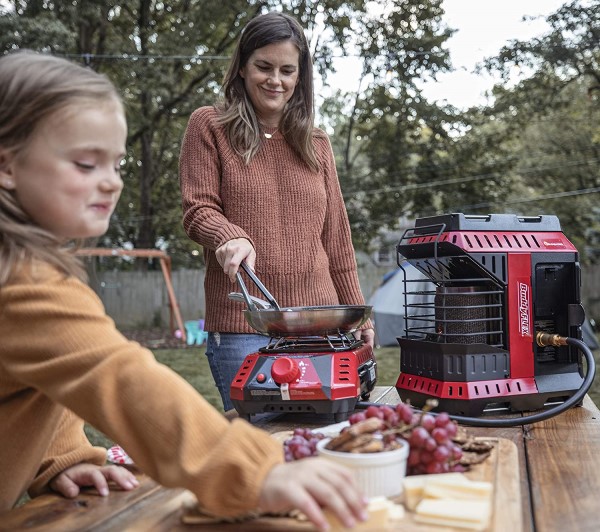
Most propane heaters have an electric piezo ignition, where you can fire up the unit by just pressing a button. Some connect directly to a standard 20-pound tank, but smaller units like the Mr. Heater Buddy models take one-pound propane cylinders that neatly pack inside the unit like batteries. Some take just one cylinder while larger models like the Big Buddy take two. The one-pound cylinders can be purchased online and shipped directly to your home, and they run about $10-12 a piece.
You can save a little money by refilling the small tanks from larger 20-pound tanks with an adapter. The trick is you need to put the small tanks in the freezer first. Then you connect the adapter to the tank, turn the tank upside down, screw on the cylinder, and then open the tank valve.
You can also buy adapter hoses to use larger tanks with these heaters, but it’s recommended to keep the big tanks outside, though a lot of people bring them inside with no problems.
Kerosene
Some swear by old-school kerosene heaters, since they get hotter faster than propane. However, kerosene has some major downsides. The heaters have a definite smell, which you might enjoy, but can lead to lung irritation. Kerosene heaters also need cleaning and maintenance.
Kerosene is much easier to store than gasoline or propane because it has a very long shelf life, doesn’t require special storage containers or pressurization, and does not ignite easily. Kerosene may be easier to find in your area than propane, though propane seems to generally be more available these days.
Alcohol
Alcohol is another option for emergency heating. However, alcohol is more expensive than propane and kerosene, which is why it isn’t commonly used for heating fuel. The alcohol stoves you’ll find on the market tend to be aimed at backpackers and will work in a pinch, but you are better off with propane. Propane also puts out more BTUs when compared to alcohol. One advantage backpack style alcohol stoves do have is that they are very compact, and they can adequately heat up a small space. For example, the Dometic ORIGO 5100 Heat Pal Alcohol stove can burn for 5 hours on 1 quart of denatured alcohol, and create 5,200 BTUs which is enough to heat a 120 square foot room. Alcohol stoves can also be used at elevations above 9,000 feet.
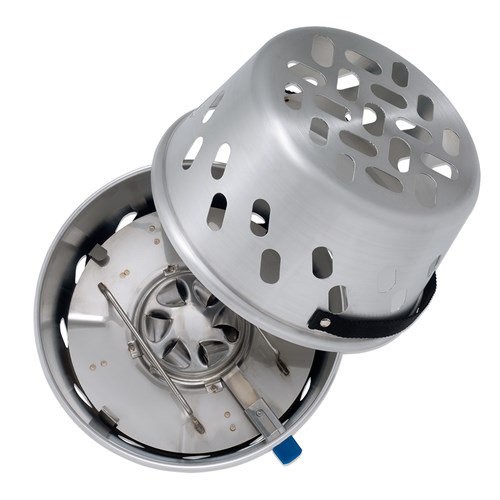
You can burn a wide variety of alcohol in an alcohol stove, though common alcohol camp style stoves are designed for denatured alcohol. The kind of alcohol you likely already have in your home is isopropanol, also known as isopropyl alcohol or rubbing alcohol. It produces soot and toxic fumes, so it isn’t ideal, but it’ll work in a pinch.
Tip: Make sure to seal your denatured alcohol in a tight container. It will evaporate if not sealed properly.
Wood and similar
Wood burning stoves serve as a primary heat source for a lot of people. These stoves vent through a chimney or wall, and can be a stand alone stove, or retrofitted into a fireplace. If you have a wood stove, awesome. You can cook, bake, and as long as it has an accessible flat top, boil water with it. Wood can be easily stored, and in SHTF emergency, foraged. Even if you burn wood, a portable propane stove is still not a bad idea. In the event that you are injured or otherwise cannot carry or forage for wood, a small portable propane stove is easy to turn on and operate.
Portable camp stoves are a great backup heat source, especially if you have access to wood. Unlike propane haters which require minor ventilation, wood stoves need a place to vent lots of smoke.
Some preppers will create a vent through the wall that can be used in an emergency, or vent through a window. Venting through a window will require a heat resistant collar or window plate kit to support your stove pipe. A lot of preppers use plywood and a steel panel that can accommodate the angle of the stove pipe. The window vent is easy to prepare for in advance and can be set up quickly.
Stoves like the recommended Camp Chef Alpine Heavy Duty Cylinder Stove are heavy and slightly cumbersome, but will produce a lot of heat and allow you to cook and boil water. It also has a drying rack to dry off clothing. The heavy steel will also hold and radiate heat, keeping your space warmer for a longer period of time.
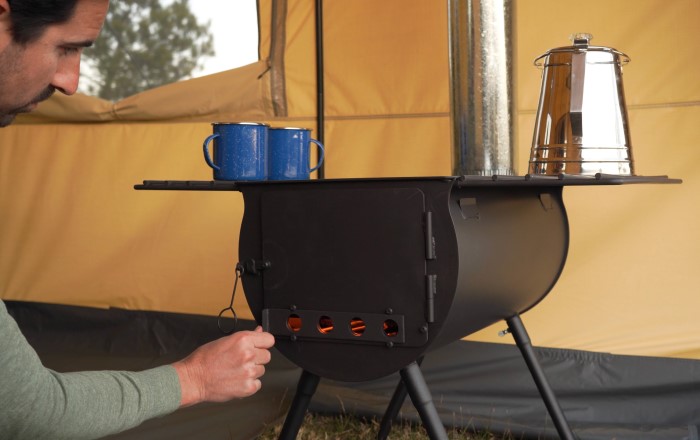
Small camp stoves like the Winnerwell Woodlander Tent Stove weigh around 20 lbs. They cannot hold a lot of wood, and the wood must be small, however these little stoves can be used to boil water and cook and will provide sufficient heat for a hundred square foot room. A huge advantage is that they can be tossed in a vehicle and don’t take up a lot of space.

